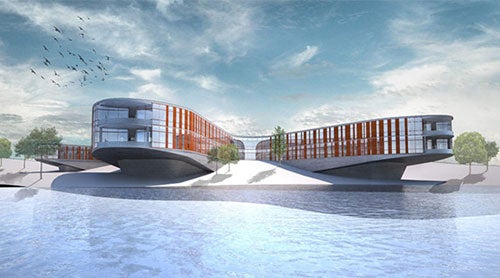Xiaobo Quan leads Center for Health Research & Design at Washington University

Architecture students in the Sam Fox School of Design & Visual Arts created speculative designs for a rehabilitation hospital.
Health care architecture is an art and a science, and the science side is taking center stage with the growing support behind evidence-based design.
The Center for Health Research & Design (CHRD) at the Sam Fox School of Design & Visual Arts at Washington University, St. Louis, is one of the more recent members to join this growing class of health care evidence-based design researchers. Xiaobo Quan, an architect whose career spans the U.S. and China, has joined as the CHRD’s director. He previously served as a senior researcher at the Center for Health Design in Concord, Calif.
The center formed earlier this year and is one of 17 academic partners part of the American Institute of Architects Design & Health Research Consortium. Quan says the center’s purpose is to address challenges posed by a changing health care environment and delivery models. The group will also help meet future health and wellness requirements by integrating research in architecture, urban design, communication design and art.
“The role of environment and visual design on improving human health and health care delivery has been increasingly recognized by health care providers, designers, policy-makers, etc.,” Quan says. “To build better environments for health and health care, organizations and designers need access to research-based knowledge around the effectiveness of environmental strategies and how they interact with other factors such as hospital operations. However, there are many gaps in research. Therefore credible research is much needed.”
CHRD is collaborating with local nonprofit health care organization BJC HealthCare on three evidence-based design research projects that look at key health care environments. One projects focuses on health care office spaces, with the goal of helping to increase staff satisfaction and retention, produce operational savings and reduce financial complications that can result from poorly designed space.
Another study will focus on measuring performance in patient room design. The researchers will first identify a hypothesis that links a design feature with an intended consequence and then test that hypothesis by measuring effectiveness in the built environment.
The last project focuses on ambulatory surgical environments. The purpose of the project is to develop metrics to support continuous design optimization of ambulatory surgical care. The group will research evidence and evaluation of existing facilities and compare multiple facility designs, looking for trends in efficiency, safety, and patient experience and outcomes. Quan says all three projects are in stages of evaluating environmental design and planning outcome data collection.
The results of these studies will add to a growing body of research that is continually proving and disproving what does and does not work in health care design. Take for instance, the rise in single patient rooms. Old-school hospital layouts favored “multi-bed rooms or open bays which were widely used and thought to facilitate visual surveillance for patient safety,” Quan explains. However, thanks to growing research, the health care community found that the benefits of improved infection control, privacy, stress reduction, noise reduction, and patient satisfaction gained through single patient rooms tend to outweigh potential reduction of surveillance visibility. And even that visibility issue can be mitigated through the use of decentralized nursing stations.
“Patient experience is becoming more and more important,” Quan says. “We need to better understand the role the physical environment can play.”

